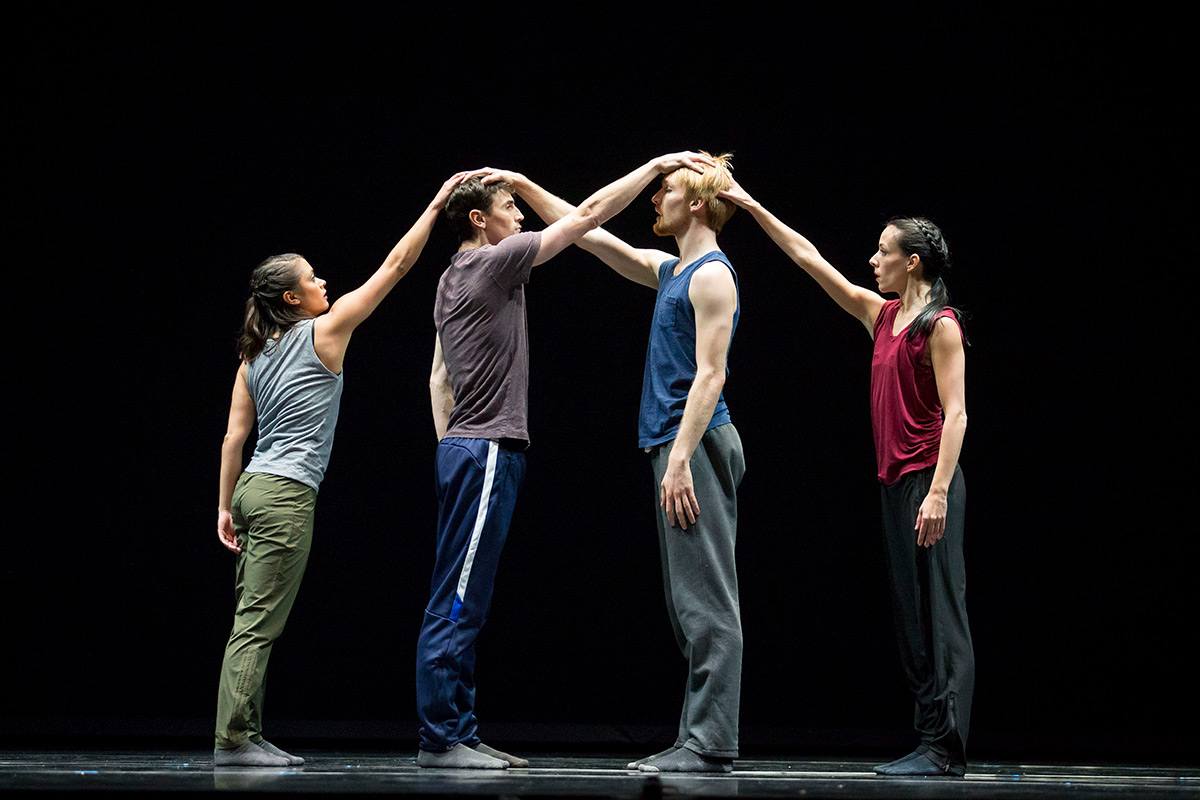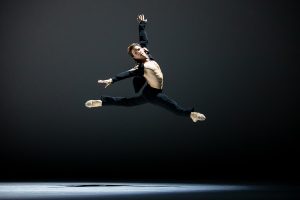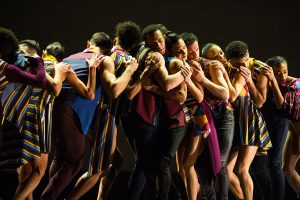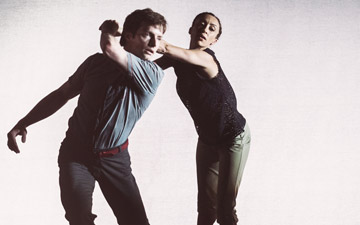
© Todd Rosenberg. (Click image for larger version)
Hubbard Street Dance Chicago
Program A: Jardí Tancat, N.N.N.N., Lickety-Split, Grace Engine
★★★★✰
Berkeley, Zellerbach Hall
18 January 2019
www.hubbardstreetdance.com
calperformances.org
Last Friday night a Cal Performances favorite returned to Berkeley – Hubbard Street Dance Chicago. For their fourth engagement, the dynamic contemporary group brought two programs with a whopping nine works, three of which were Bay Area premieres. I caught Program A’s quadruple bill, and if that performance was any indication, Hubbard Street is another company that will be in dialogue with Cal Performances’ patrons for some time to come.
Program A’s works were from four different choreographers, so there wasn’t a single dominant voice. And that, in addition to the undeniably stellar dancing, was what made the evening special. Every piece had a unique flavor and quality. The modern masters were represented, as were the post-modernists. Abstract choreography abounded, as did movement that felt informed by narrative themes and emotional states. Gesture was present. So was incredibly intricate technical partnering. In less than two hours, Hubbard Street had given the audience a terrific sampler of contemporary dance performance and highlighted the genre’s immense breadth and depth.

© Todd Rosenberg. (Click image for larger version)
Jardí Tancat and Lickety-Split were familiar, as they are also in SFDanceworks’ rep and have been part of that local company’s recent home seasons. Each impressed when I saw them in 2018 and 2016 respectively, and here, that feeling continued. Jardí Tancat, choreographed by Nacho Duato, is a love letter to a rural community. Scored by María del Mar Bonet’s folk songs, the sextet is an ode to their daily lives – their work, their relationships and the circumstances that they face. Connectedness to the earth was revealed in the movement – palms stretched down towards the ground; legs pulsed in deep, second positions. There was an equal curiosity about the future as eyes surveyed the horizon and the upper torso expanded towards the heavens. Created in 1983, Jardí Tancat was the oldest work on the bill and it definitely has a retro feel to it, which I love. With clear positions and strong lines, this dance conjures and evokes so many mid-century modern dancemakers: Horton’s diagonal arms and lateral postures, Graham’s extreme lay-outs and full-body tilts, the momentum and swing that is foundational to Limón technique. Save for a few eponymous companies, these styles feel somewhat out of the current contemporary dance zeitgeist, and that is a shame. Such clear and powerful vocabulary is very fitting for works that celebrate resilience, like Jardí Tancat.

© Cheryl Mann. (Click image for larger version)
Also a dance for six, Alejandro Cerrudo’s Lickety-Split (2006) is an enchanting surprise. With such a title, one might expect super fast movement or a pulsing, frenetic score. But neither of those of things is true. Instead, the viewer is treated to a collage of chill dance episodes (not in difficulty, but in tempo) and an array of emotional qualities, all set to Devendra Banhart’s laid-back, psych-folk songs. With lengthy embraces, an early duet speaks of passion and yearning. A later solo and its shifting directions suggest uncertainty. During a group vignette, the women were lifted into the air, their legs cycling on an imaginary bicycle – they were on a journey, searching for something, maybe someone. Unison sequences breathed togetherness and camaraderie into the space; other exchanges brought humor. Watching all of these tones unfold, I came back to Cerrudo’s chosen title and realized there was something in Lickety-Split that felt quick – the changes between theses different emotions. Perhaps the human ability to shift from one state to another was the primary message.
Another title that struck was William Forsythe’s N.N.N.N. (2002), a quartet danced by Jacqueline Burnett, Ana Lopez, Andrew Murdock and Kevin J. Shannon. Immediately N.N.N.N. brought to mind quantitative/qualitative experimentation, sample sizes and case studies. And as a soloist began exploring the movement possibilities of his hand and arm, it seemed a post-modern dance experiment was indeed underway. The three other performers entered the scene and the experiment went on. Hands and arms continued to be mined for information and observation, the head, torso and legs soon joining as additional data points. As the experiment’s parameters grew and accumulated, so too did the dynamics, speed and rebound of the movements. And the quartet also provided the live score with a vocal set of robotic sounds and noises. The performers were incredible, navigating N.N.N.N.’s constant motion and sound, no question. And I’m someone who likes deconstructed choreographic/movement studies, and the dance-y sequences, pedestrian phrases and funny interactions that often emerge from them. But even my interest can only be held for so long, and N.N.N.N. went past that point.

© Todd Rosenberg. (Click image for larger version)
If I had to choose one word to describe Crystal Pite’s Grace Engine (2011), it would be cinematic. With its combination of pulsing physicality, theatrical lighting and what felt like a non-linear narrative, Grace was a stunning finale to Hubbard Street’s wonderful program. It was like a suspense movie, charged with a range of moods and plotpoints – exciting, spooky, athletic and breathtaking, all at the same time. First came a sense of eeriness and panic. Train sounds were marked by loud, halting footsteps. Dancers peered over their shoulders, checking that nothing was following them. They froze in static poses, hands splayed, unable to move. They broke into silent screams. Next came conflict. Two groups faced each other in an ominous standoff. Again, their palms were energized and their long lunges suggested that they were about to pounce, or maybe, to run. These stances would suddenly explode upward and outward, their ire uncontainable. Then, acquiescence. The two groups realized that their battle was not with each other but with something bigger. They came together in larger group phrases, often moving in unison to establish a unified front. And as Grace reached its final third, there was a renewed anxiety. The return of the score’s footsteps signaled that whatever force the group had been battling remained undefeated. It was such a thrilling ride that, like N.N.N.N., went on just a bit too long.
I only wish Hubbard Street’s Berkeley run could have been longer than three performances, and based on the audience’s cheers and applause, I don’t think I was alone. There were two opportunities to see Program A, but only one chance for Program B. Hopefully an extended Cal Performances run is on the cards soon.

















You must be logged in to post a comment.